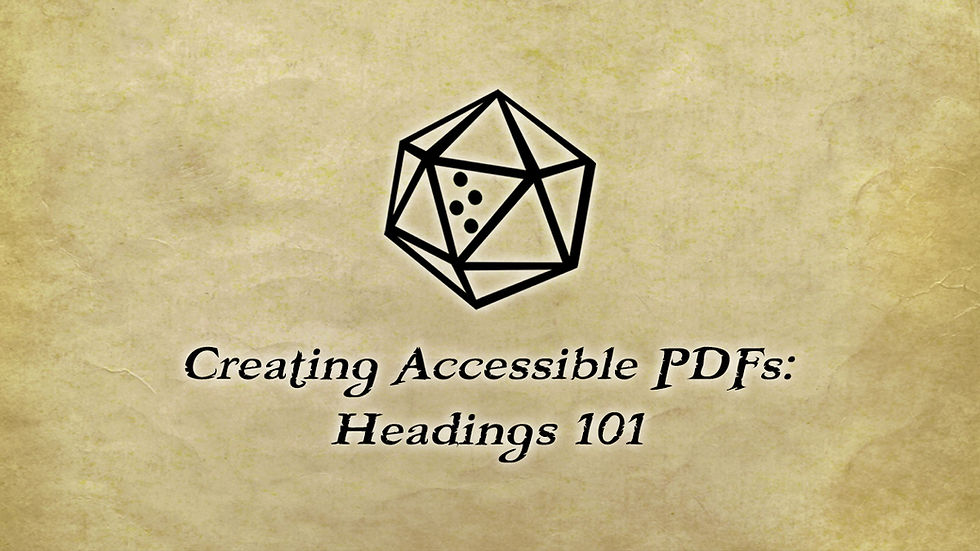Creating Accessible PDFs: Readable Text 101
- DOTS RPG Project

- Nov 28, 2020
- 4 min read
Updated: Jan 16, 2021
Greetings, Adventurer! The DOTS Guild welcomes you once more on your journey to learn, and we are happy to be of service. This missive provides information on how to make the writing in your tomes easier to read. Should you have any further questions, please contact our Guild Leaders for assistance!
This document gives an overview on the different ways you can ensure your document has readable text, addressing a few main points to consider, each one applicable in different situations. Readable text is the concept used to describe printed and digital text that has been designed with an eye towards legibility, specifically for people with low vision, dyslexia, Irlen Syndrome, and other visual processing disorders. Readable text can be the difference between whether or not a document is accessible. Though the examples described in this document may not work for everyone since there are differences person to person, using this guide can help a vast majority of individuals with visual processing disorders. With the seemingly endless font options available in programs and online, where to begin?
Selecting your typeface is often the first step in determining the look and feel of your content. Font family, type size, and style are all factors that can affect readability. Serif typefaces like Times New Roman, Garamond, and Georgia have extended finishing strokes, called serifs. Occasionally these serifs are distracting and make text harder to read for someone with visual processing disorders. Sans-serif typefaces such as Arial, Avenir, and Calibri do not have these extended finishing strokes, and are generally easier to read for those with visual processing disorders. When emphasizing text, bolded text is often easier to read than italicized or underlined text. Additionally, ensuring kerning (letter spacing) and line spacing are even and consistent is important to make your text as legible as possible. Depending on the font, a size 12pt or larger with line spacing at 1.5 is a good baseline. The three fonts in the image below are all at the same size but display at a different scale depending on the style. Some typefaces like OpenDyslexic have been created with a specific reader in mind. The heavier line weight on the bottom of each letter helps someone with dyslexia be able to quickly differentiate the top from the bottom, making letters quicker to recognize. Additionally, letters that may look similar to each other in different fonts such as lowercase b, d, p, q, capital I and lowercase l all have unique designs in OpenDyslexic.
When it comes to titles, chapter or section headings, and other areas where you have a major callout, you may want to select a stylized typeface that differs from your main text. Something dramatic and fancy might be desired to set the tone for the reader, though it may not always be the best option. Say for example you want something to fit a medieval setting. You can select from options that look like handwriting with fancy elaborate letters, but those are often distracting and difficult to read, especially if they have letters that are irregular in size, scale, and position. You may be able to find something that meets your desire for a handwriting style but is still legible by most readers. In the image below, the first line of sample stylized text has multiple factors that contribute to enhanced reading difficulty. Letters are fractured, at different angles, and spaced differently. Additionally, letters that should extend below the bottom of others (like lowercase p, y, and the cursive style z) are not consistent in their positioning, and there is not enough of a size difference between capital and lowercase letters. The second line of sample stylized text is easier to read with clean, consistent letters and positioning, though the serifs on all letters and design of lowercase y, z, and capital T may be distracting for some. Finding the best readable typeface that works for you and your content may take some trial and error, but ensuring it is accessible to readers with visual processing disorders is worth the work.
Once you have an accessible typeface, layout is next! Graphics are often a major part of content and can be alongside the body of text in different situations. There may be an image of something being referenced in the nearby paragraph, a stylized notation, or a detailed background. Ensuring text doesn’t overlay complex graphics, using simple backgrounds, or adding a plain background between text and a graphic can assist with accessibility. When using a colored background or graphic, it is important to use high contrast to clarify text. Where possible, text should be placed adjacent to an image, rather than overlaid on top of it. If overlaying text, back the text as seen in the image below. If you are providing an image with text inside it, especially where the text in the image is in a difficult-to-read font (like an image of a handwritten note, or runes carved into stone) it’s helpful to include a transcription in the main text, glossary, or index. Considerations for colorblind readers should also be made when using graphic backgrounds and/or colored text and backgrounds. While there are multiple kinds of colorblindness and varying expressions therein, some design programs and many free websites offer simulators that can be used to check your content for readability.
Creating content that is accessible is a great way to ensure the most amount of people get to enjoy your work. Factoring in accessibility considerations from the start enhances the quality of your content and shows you have taken the time to think about the finished product. Though this is a non-exhaustive guide on readable text, it is a great resource to get you thinking!
If you have any questions or would like to get in touch, please contact us.











Comments